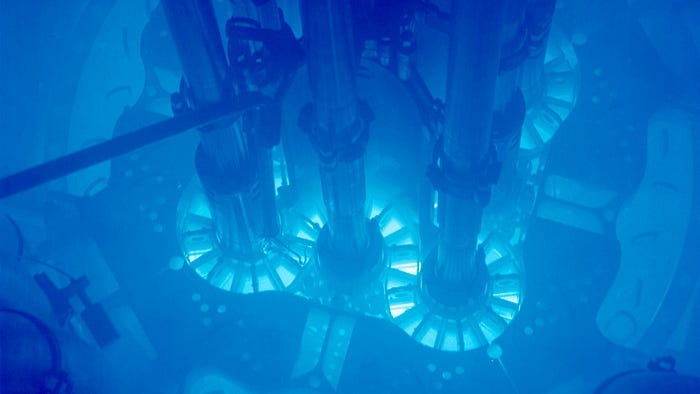China's Meltdown-Proof Nuclear Reactor Is Genius
But it's ridiculous we don't have the same technology.

Nuclear power is spectacular. It is statistically one of the safest forms of energy we have while also producing less carbon emissions per unit of energy than renewables, and unlike renewables, nuclear power is on demand. But, it is by no means perfect. Nuclear power is insanely expensive, partly thanks to the understandably vast safety requirements. However, the public and politicians aren’t aware of how safe nuclear power actually is, and as such, there is significant political pushback against nuclear expansion. But China has killed these two birds with one stone with their new revolutionary meltdown-resistant reactor.
But before we look at this astonishing reactor, we first need to recap how a nuclear reactor works and what a meltdown is.
It begins with nuclear fuel, which is typically uranium. Nuclear fuel is “enriched” to contain a larger amount of the isotope uranium-235 (U-235), typically so that 5% of its mass is U-235. U-235 isn’t that radioactive on its own, but it can absorb low-energy neutrons and turn into U-236. U-236 is incredibly unstable and almost instantly splits into three free neutrons, krypton, barium, and a lot of energy in the form of heat. These neutrons can go on to cause three more atoms of U-235 to split (also known as fission), allowing for a nuclear chain reaction to take place. The by-products, krypton and barium, are radioactive and split into numerous elements over thousands of years, which is why nuclear waste is radioactive.
All a nuclear power plant does is harness this heat to turn water into steam, blow this high-pressure steam through a turbine to make electricity, and control the nuclear chain reaction.
The vast majority of nuclear reactors use graphite control rods to mediate the reaction. These absorb the neutrons, dramatically slowing down the reaction. As such, inserting these rods into the reactor slows down the reaction, and removing them speeds it up.
Okay, so what is a meltdown?
Very rarely, a nuclear incident occurs where the control rods fail, and the nuclear chain reaction spirals out of control. An insane amount of heat builds up in the nuclear fuel, and once it surpasses 4,700 F (1,600 C), it melts. This superheated, highly radioactive lava flows to the bottom of the reactor and can melt the reactor encasement and cooling system. It can then escape confinement and spread highly radioactive particles into the surrounding environment.
This is partially why nuclear power is so damn expensive. Every precaution has to be taken to ensure this scenario doesn’t happen. As such, everything from the reactor design to the reactor’s location to procedures in case of an emergency must be thoroughly tested and approved, which takes years and tens of millions of dollars to conduct.
But what if we created a reactor that simply couldn’t meltdown, no matter the circumstances? Not only would it alleviate much of the political pushback to nuclear power, but it could also make nuclear power significantly cheaper.
Well, that is precisely what China’s High-Temperature Gas-Cooled Reactor Pebble-Bed Module (HTR-PM) reactor aims to do.
As the name suggests, this uses pebble-bed technology to be meltdown-resistant. Rather than using fuel rods and control rods, it uses graphite pebbles about the size of a tennis ball. Inside these pebbles are thousands of tiny nuclear fuel particles coated in many layers of heat-resistant ceramic known as TRISO particles. The graphite casing acts as the control rods, meaning the nuclear reaction is always restrained. But, even if the nuclear reaction gets out of hand, the ceramic coating of the TRISO particles keeps the nuclear fuel contained, even if it melts. As such, this reactor can reach temperatures way above the meltdown point and still remain safe.
But, more than that, these pebbles have a far larger surface area than typical nuclear fuel rods and, as such, can be passively cooled much quicker, meaning this reactor is far less likely to reach meltdown temperatures than a typical reactor.
All of this means that this nuclear reactor is meltdown-proof!
The HTR-PM is the world’s first commercial reactor to use this technology. So, we are still waiting to see if it actually delivers its promised benefits.
But here is a fun titbit. China didn’t invent this technology. In fact, it was invented by an American in the 40s, and commercialisation started in West Germany in the 60s. The work done in the 60s was then licenced off to China to finally turn it into a viable product. So, while it is incredible that this technology is finally coming to fruition, it is damning that we in the West couldn’t see it through. Our nuclear industry is stalling, and innovations like this can save it; we just have to commit to taking atomic energy to the next level.
Thanks for reading! Content like this doesn’t happen without your support. So, if you want to see more like this, don’t forget to Subscribe and help get the word out by hitting the share button below.
Sources: Intellinews, IE, WNN, Energy.gov, Study.com, Will Lockett, Will Lockett, Layfette University

